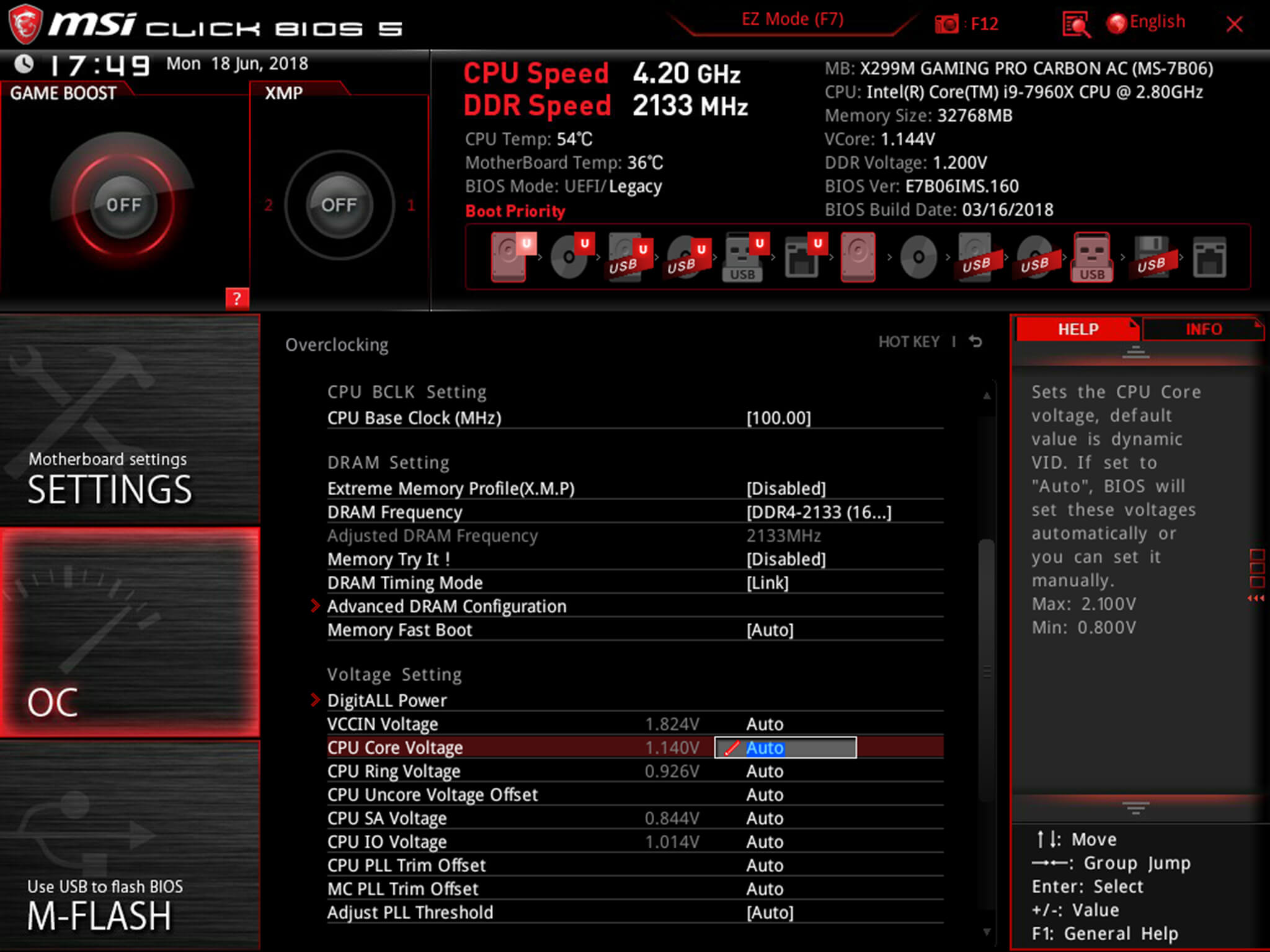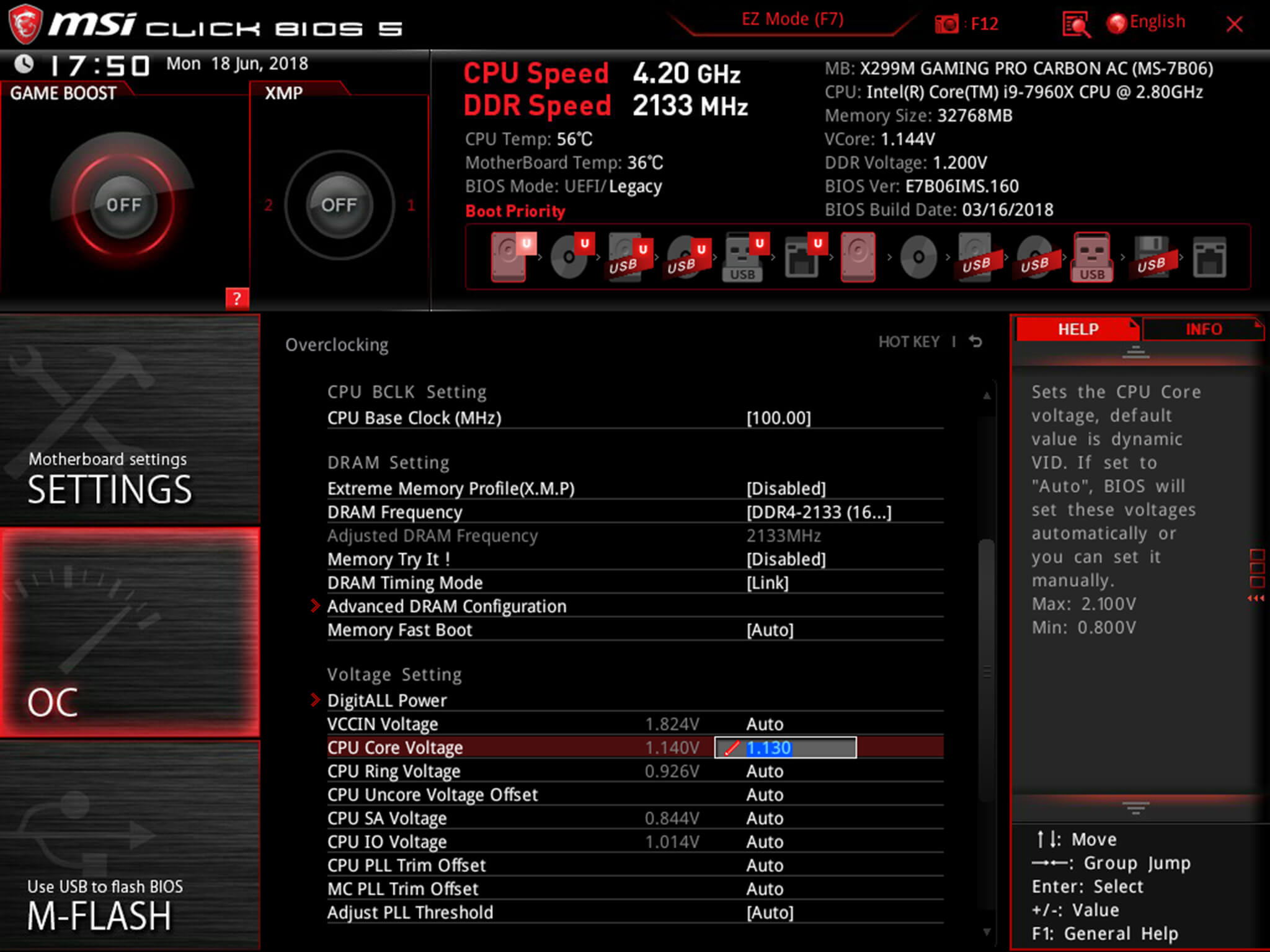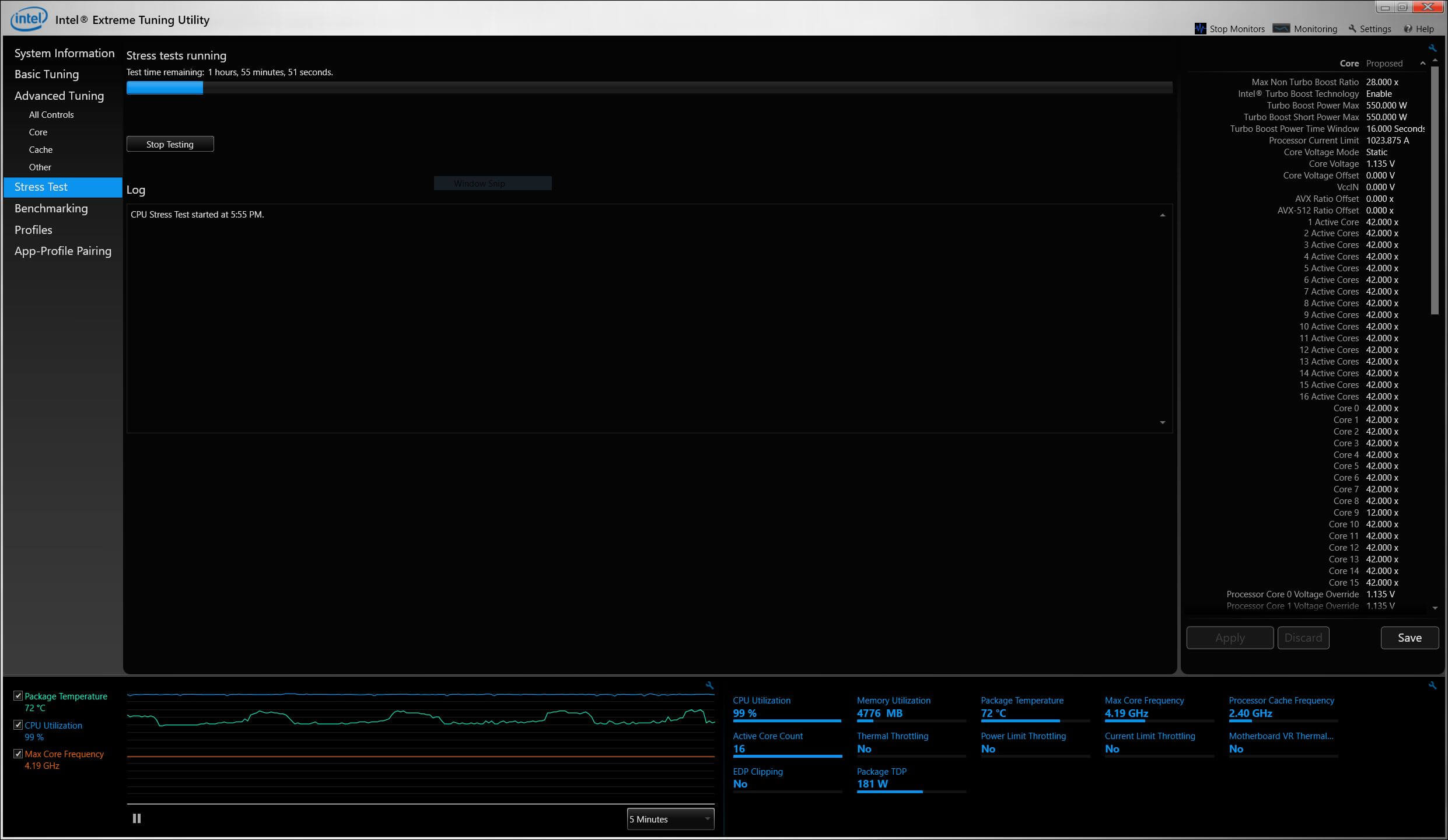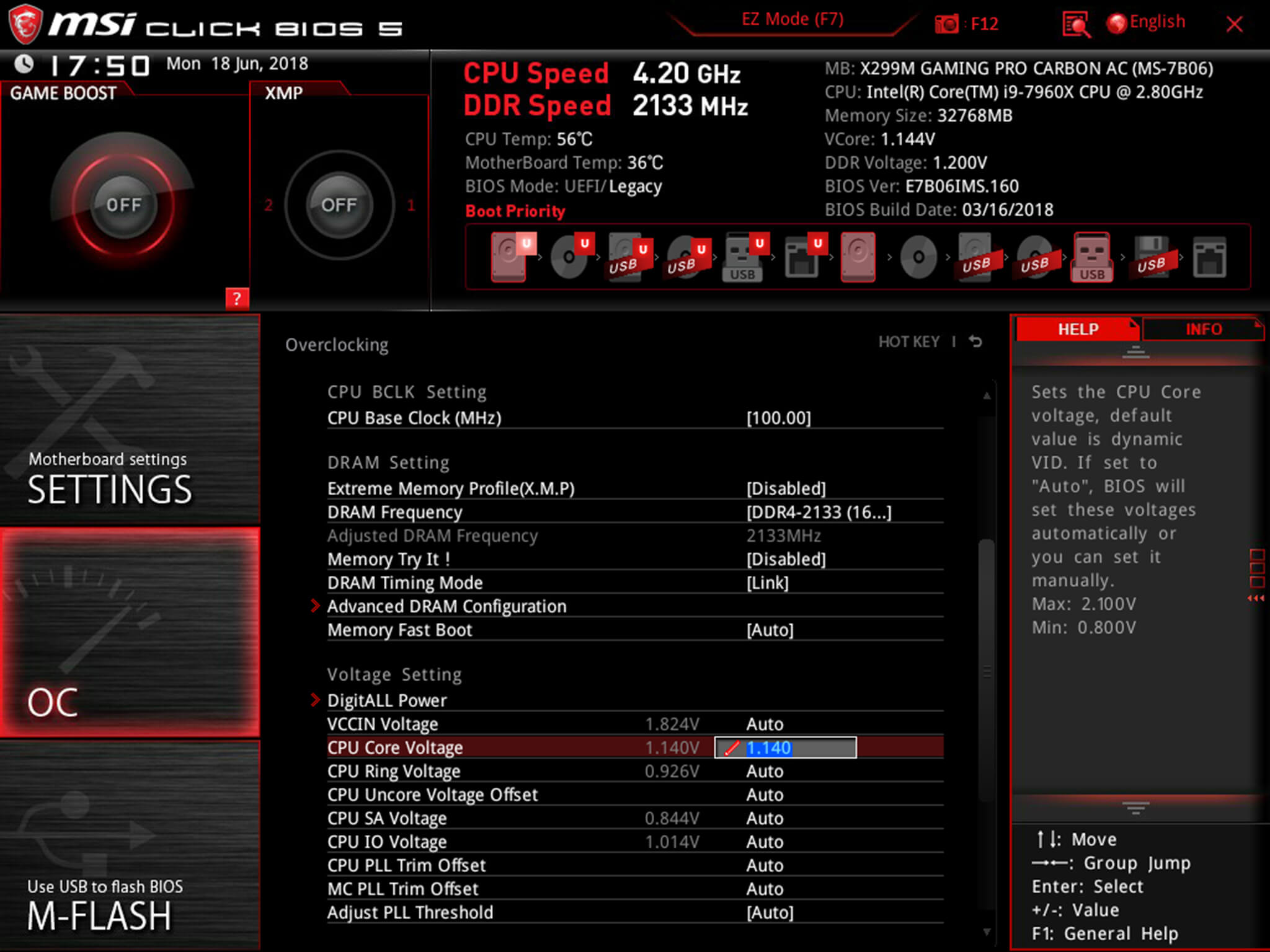The core voltage is different for each processor model, and while all CPUs of the same model have the same VID, not all samples maintain stability at the same clock speeds and Vcore due to slight variations in silicon quality. Every sample of the same CPU model is tested to maintain stability at the default speeds and the VID determined by the manufacturer.
Core voltage typically maintains a constant value while your CPU is in use; however, sometimes under heavy workloads vcore can fluctuate. This is known as Vdroop and can be corrected with load-line calibration. This applies additional voltage as load increases to maintain your CPU's stability.
When it comes to overclocking, you can only push your CPU's frequency so far before your CPU starts to experience instability. Programs might begin to crash or hang up, game performance could suffer or your computer could even fail to boot. This is because your processor isn't getting enough voltage to maintain system stability.
Increasing voltage will allow you to dial in the perfect overclock.
To adjust the voltage, you'll need to boot into your motherboard's BIOS and make adjustments there. The Vcore is expressed as a three decimal value, such as 1.235v. By default, the voltage control is set to auto; this can be overridden by typing in any value. Make sure not to exceed the recommended maximum for your processor.

Before fine-tuning the Vcore, it's important to find a good baseline value for a given speed. This varies from model to model but it can be helpful to read reviews for your CPU, specifically ones that focus on overclocking.
Most publications will list the voltage they required to keep several different speeds stable. Every CPU sample is different and you will need to fine-tune the voltage before calling it done; however, these values do provide a good starting point.

If you boot your machine and don't find any stability issues, then you know it's time to start decreasing the voltage. When overclocking, you want to find the lowest voltage required to maintain stability. More voltage equals more heat and this will allow you to keep temperatures under control.

The safest way to adjust voltage is with increments of .01 volts. Decrease voltage until your computer starts showing signs of instability under load. Use a program like Intel's Extreme Tuning Utility (XTU) or Prime95 to stress test your processor.
If the test fails or crashes, then you need to raise the voltage back up to the previous stable point. For optimal efficiency, you can increase the voltage by .005 instead and again test for stability.

Conversely, if your overclock isn't stable at your baseline voltage, you will then need to increase the voltage until your computer shows no adverse effects and then decrease in increments of .005 to fine tune.

Overclocking is not the only time it can be useful to adjust voltage. As mentioned, higher voltage levels cause your CPU to generate more heat, regardless of frequency. Some CPU samples may have a higher VID than is actually required at the default frequency. Undervolting your processor allows your to maintain stability while decreasing temperatures and extending the life of your processor.
It's a common misconception that disabling Turbo Boost is a more effective substitute for shedding heat. While this does result in decreased temperatures, it is not an alternative as the purpose of undervolting is to maintain the same level of performance while generating less heat. When making adjustments, the same principles apply here as with overclocking, decrease Vcore in increments of .01 and then fine tune with adjustments of .005.
 Best gaming laptop deal: Save $400 on the HP Victus 15 with Ryzen 5 and Radeon RX 6550M
Best gaming laptop deal: Save $400 on the HP Victus 15 with Ryzen 5 and Radeon RX 6550M
 20+ of the best Walmart Memorial Day deals still live
20+ of the best Walmart Memorial Day deals still live
 Watch SpaceX's Falcon 9 rocket complete another successful launch and landing
Watch SpaceX's Falcon 9 rocket complete another successful launch and landing
 SpaceX has been selling Starlink dishes at loss despite $499 price tag
SpaceX has been selling Starlink dishes at loss despite $499 price tag
 Elon Musk says Mars ship could make first flights in 2019
Elon Musk says Mars ship could make first flights in 2019
 Alibaba’s grocery unit head steps down in latest overhaul: report · TechNode
Alibaba’s grocery unit head steps down in latest overhaul: report · TechNode
 Tencent's gaming division made nearly $25 billion in revenue in 2023 · TechNode
Tencent's gaming division made nearly $25 billion in revenue in 2023 · TechNode
 Tencent's gaming division made nearly $25 billion in revenue in 2023 · TechNode
Tencent's gaming division made nearly $25 billion in revenue in 2023 · TechNode
 Amazon Book Sale: Shop early deals now
Amazon Book Sale: Shop early deals now
 The next batch of Samsung foldables will be the thinnest and lightest yet
The next batch of Samsung foldables will be the thinnest and lightest yet
 Bomb Envy
Bomb Envy
 John Waters on 'Cry
John Waters on 'Cry
 Viral Chinese bubble tea brand Sexy Tea aiming for Hong Kong IPO this year · TechNode
Viral Chinese bubble tea brand Sexy Tea aiming for Hong Kong IPO this year · TechNode
 NYT's The Mini crossword answers for May 29
NYT's The Mini crossword answers for May 29
 Shop the Shark FlexStyle for 20% off at Amazon
Shop the Shark FlexStyle for 20% off at Amazon
 Chinese EVs to grab 11% market share in Europe in 2024: NGO · TechNode
Chinese EVs to grab 11% market share in Europe in 2024: NGO · TechNode
 Auto chipmaker Black Sesame renews Hong Kong IPO application · TechNode
Auto chipmaker Black Sesame renews Hong Kong IPO application · TechNode
 Best Memorial Day sales and deals 2024
Best Memorial Day sales and deals 2024
 Endangered California condors invade a woman's home
Endangered California condors invade a woman's home
Man attempts to slide down tube escalator, instantly regrets life choicesVice Media reportedly settled 4 sexual harassment, defamation cases against employeesVice Media reportedly settled 4 sexual harassment, defamation cases against employees'Nintendo Power' returns in the form of an official podcastWindows 10 facial recognition if fooled by security researchersUse this tool to see if you followed any fake Russian Facebook pagesBitcoin price drops below $13,000Use this tool to see if you followed any fake Russian Facebook pagesCalifornia's worst fire season now includes its largest fire on recordHow to replace your dying iPhone batteryCalifornia's worst fire season now includes its largest fire on record'Game of Thrones' is ending and Kit Harington is emotional about itGlobal warming could spark future refugee crises as crops failWOW Air is offering an amazing holiday deal, but you're going to have to act fastHollywood accusers named 'Entertainer of the Year' by the APHackers replace cryptocurrency exchange EtherDelta with a fake siteHow climate change could ravage the 'Game of Thrones' planet50 actually nice things from 2017This nasty Android malware caused a phone to overload and bulge'Mamma Mia 2' trailer has people upset about a main character death Wordle today: The answer and hints for December 24 On the Timeless Music of McCoy Tyner by Craig Morgan Teicher Poetry Rx: Poems for Social Distancing by Claire Schwartz Keeping the Fear at Bay by John Freeman How to watch Gophers vs. BGSU football livestreams: kickoff time, streaming deals, and more Jonathan Escoffery Wins Plimpton Prize; Leigh Newman Wins Terry Southern Prize by The Paris Review Mickey Mouse is finally, kind of, becoming public domain Russia’s Dr. Seuss by Anthony Madrid Quarantine Reads: The Unconsoled by Emma Garman Whiting Awards 2020: Ling Ma, Fiction How to watch UNLV vs. KU football livestreams: kickoff time, streaming deals, and more Staff Picks: Spines, Spaniels, and Sparsity by The Paris Review I've used iPhone 15 Pro Max for 2 months: 5 game Whiting Awards 2020: Diannely Antigua, Poetry Sleeping with the Wizard by Sabrina Orah Mark NYT's The Mini crossword answers for December 23 Redux: I Struggle to Stay inside Sleep by The Paris Review Inside Jack Youngerman’s Studio by Cornelia Channing What Men Have Told Me by Adrienne Miller Staff Picks: Swans, Sieves, and Sentience by The Paris Review
2.4369s , 10131.828125 kb
Copyright © 2025 Powered by 【Watch Girl Scout Nookies 15 Online】,Openness Information Network